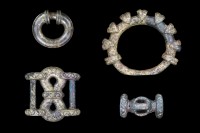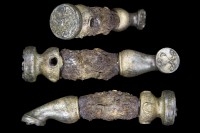 Archaeologist from the University of Leicester have found a hoard of rare bronze fittings from a Celtic chariot while excavating the site of an Iron Age hillfort on Burrough Hill near Melton Mowbray in Leicestershire. The fittings date to the 2nd or 3rd century B.C. and were deliberately buried as a religious offering.
Archaeologist from the University of Leicester have found a hoard of rare bronze fittings from a Celtic chariot while excavating the site of an Iron Age hillfort on Burrough Hill near Melton Mowbray in Leicestershire. The fittings date to the 2nd or 3rd century B.C. and were deliberately buried as a religious offering.
The hillfort has been excavated by the University’s School of Archaeology and Ancient History since 2010 as part of a five-year project to give students a chance to gain hands-on field experience while exploring the Iron Age occupation of the fort and the transition into the Roman period. In fact it was a group of four students who found the treasure. The first piece was unearthed in a deep pit they dug near the remains of a house. The rest were discovered nearby.
The fittings were put in a box and placed on a bed of cereal chaff with iron tools laid around it. The box was then burned, with the chaff possibly providing kindling as well as a cushion for the sacrifice. Once the fire was out, the offering was covered in a layer of burnt cinder and slag. Archaeologists think it could have been part of a religious ceremony marking the change of a season, or perhaps something related to the construction of the nearby house.
 These are incredibly rare and highly prized objects, a matched set of chariot fittings that could only have belonged to someone of very high status, a lord or warrior. Cleaning revealed intricate decoration on the bronze pieces, including a triskele motif of three interlocked spirals popular in Celtic art.
These are incredibly rare and highly prized objects, a matched set of chariot fittings that could only have belonged to someone of very high status, a lord or warrior. Cleaning revealed intricate decoration on the bronze pieces, including a triskele motif of three interlocked spirals popular in Celtic art.
It’s unclear what the purpose of the iron tools was. Archaeologists suspect they may have had a horse grooming function. One of them has a looped handle and bent end with shallow notches that suggest it may have been the Iron Age equivalent of a curry comb. Two curved blades could have been hoof trimming tools or used in the production of harness parts.
 Dr Jeremy Taylor, University of Leicester Landscape Archaeology professor and co-director of the Burrough Hill field project could barely contain his awe at the importance of this find:
Dr Jeremy Taylor, University of Leicester Landscape Archaeology professor and co-director of the Burrough Hill field project could barely contain his awe at the importance of this find:
“This is the most remarkable discovery of material we made at Burrough Hill in the five years we worked on the site. This is a very rare discovery, and a strong sign of the prestige of the site.
“The atmosphere at the dig on the day was a mix of ‘tremendously excited’ and ‘slightly shell-shocked’. I have been excavating for 25 years and I have never found one of these pieces – let alone a whole set. It is a once-in-a-career discovery.”
The objects have been removed to the University’s School of Archaeology and Ancient History for cleaning, conservation and analysis. They will be put on display briefly at the Melton Carnegie Museum in Melton Mowbray, from Saturday, October 18th through Saturday, December 13th. Once the lab work is done, a permanent display will be arranged.